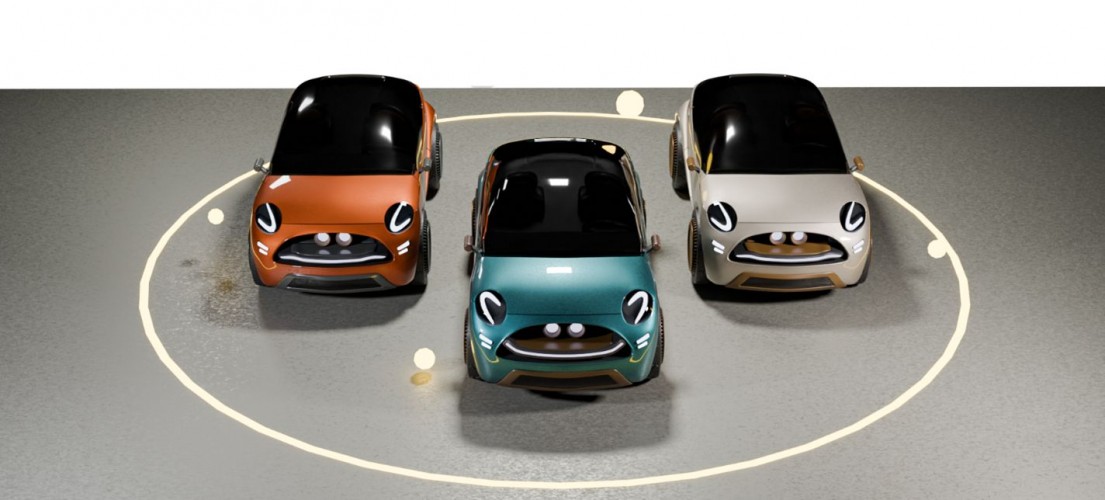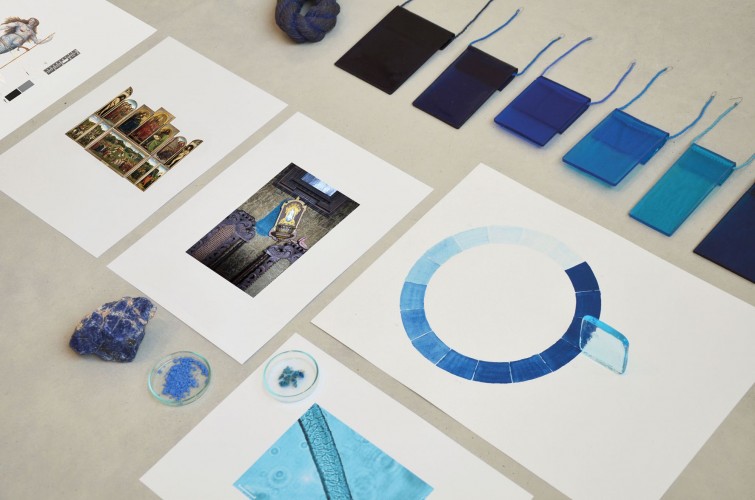Hyper-Individualism & Digitality στην τέχνη
DS.WRITER:
Σοφία Θρουβάλα
Κεντρική Εικόνα: James Welling, Morgan Great Hall, 2014. Inkjet print. © James Welling. Courtesy of Regen Projects, Los Angeles. | Πηγή εικόνας: e-flux.com
Η ραγδαία εξέλιξη της τεχνολογίας, η οποία σημειώνεται καθημερινά, σε συνδυασμό με την όλο και μεγαλύτερη προσβασιμότητα που τη χαρακτηρίζει, έχει δημιουργήσει μια σχέση αλληλεξάρτησης μεταξύ υλικού και ψηφιακού κόσμου. Η καθημερινότητά μας και η κατανάλωση του χρόνου μας στα πλαίσια αυτής είναι άμεσα συνδεδεμένες με την ψηφιακή εποχή, ενώ η συνεχόμενη προσαρμογή τής ζωής μας στις νέες ευκαιρίες που προσφέρει η τεχνολογία, μας αναγκάζει σε έναν ατέρμονο επαναπροσδιορισμό των όρων τέχνη, εργασία, επικοινωνία και αλληλεπίδραση.
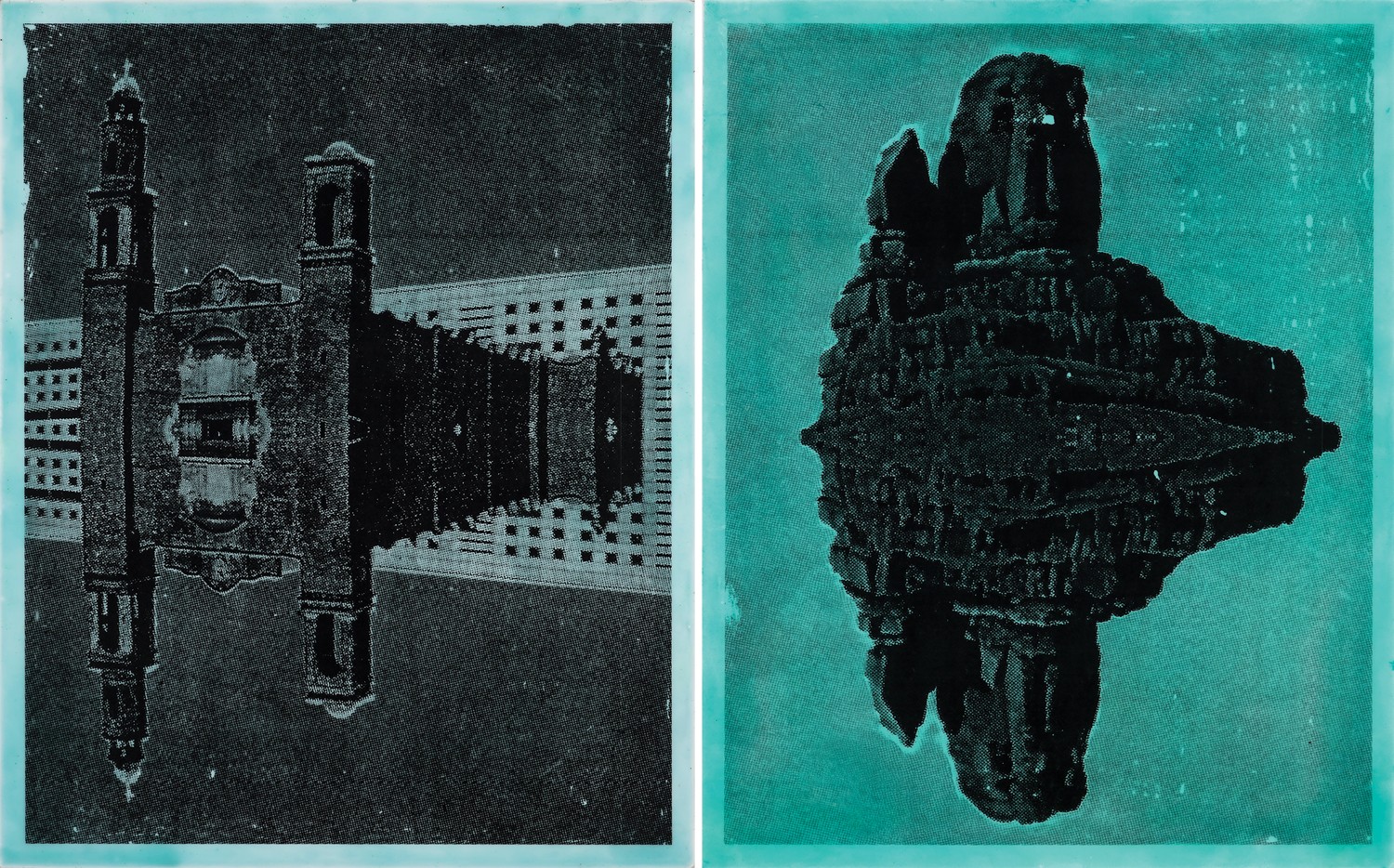
Fairs Go Digital: Fernando Castro-Caratini bought pieces by Claudia Peña Salinas (from left, Tlatelolco and Owl, both 2018) from Embajada gallery in the online version of Frieze New York.COURTESY EMBAJADA SAN JUAN, PUERTO RICO.
Η πρόσληψη της καθημερινότητας, υπό το πρίσμα της ελεύθερης προσβασιμότητας στα κοινωνικά δίκτυα και της αλληλεπίδρασής μας μέσα από νέους μηχανισμούς, οι οποίοι εκτείνονται από τα κοινωνικά δίκτυα και φτάνουν ως τον τρόπο δημιουργίας αντικειμένων design, διεκπεραίωσης ερευνητικών πρότζεκτ και διοργάνωσης καλλιτεχνικών ψηφιακών residency, μπερδεύει. Μοιάζει να δημιουργεί έναν χώρο ανοιχτό στην επικοινωνία και την πληροφορία, ενώ παράλληλα η συνεχόμενη συνδεσιμότητα δημιουργεί ένα νέο είδος υπερ-μοναδας. Η εξατομίκευση, ή, καλύτερα, η απομόνωση της εμπειρίας, στην οποία διακρίνονται χαρακτηριστικά μαζικότητας ακριβώς λόγω της συνεχόμενης αλληλεπίδρασης μέσω των κοινωνικών δικτύων, αποτελεί σημείο των καιρών.
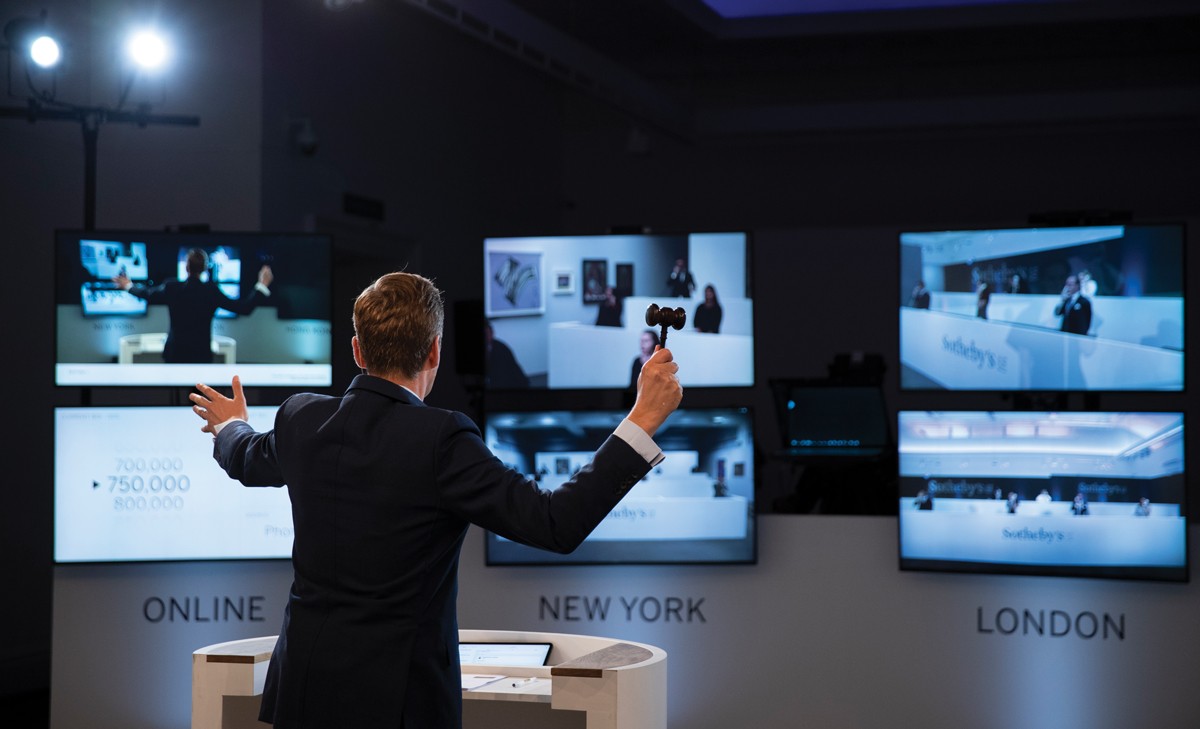
Livestreamed Art: A Sotheby’s auctioneer, based in London, taking virtual bids from specialists in London, New York, and Hong Kong, during an evening sale on June 29.SOTHEBY'S
Στον τομέα της τέχνης και του design, η ψηφιακότητα και η νέα “εμπειρία” του αντικειμένου προβληματίζουν αρκετά. Στα τελευταία δυόμισι χρόνια της πανδημίας η παραγωγή πολιτιστικών δράσεων εκτοξεύτηκε, με την αγορά έργων τέχνης να συγκεντρώνει τεράστια ποσά μέσα από διαδικτυακές δημοπρασίες, τονίζοντας τις δυνατότητες που προσφέρει η ψηφιοποίηση (digitalization), τόσο με την ανάδειξη της σύγχρονης παραγωγής χωρίς γεωγραφικά όρια όσο και με την εκτίμηση και συλλογή αυτής. Δημιουργήθηκε, έτσι, μια υπερ-μονάδα, η οποία, αυτόνομη πια -είτε αυτή είναι καλλιτέχνης, είτε αγοραστής/ συλλέκτης ή ακόμα και ερευνητής-ακαδημαϊκός κ.α-, μπορούσε να μείνει ενεργή σε έναν κόσμο που είχε πατήσει παύση.
Ωστόσο, το πρόβλημα της παρουσίας και της συνδιαλλαγής, της υλικότητας (ή της χωρικότητας) και του βιώματος που ενεργοποιεί όλες τις αισθήσεις και όχι μόνο την όραση και την ακοή, καθώς επίσης και το ξάφνιασμα της καλλιτεχνικής ή σχεδιαστικής/αρχιτεκτονικής παρέμβασης σε έναν χώρο, μένει ακόμα άλυτο, μεγεθύνοντας μάλιστα το ερώτημα που αφορά το κατά πόσο ένα έργο δημιουργείται για να καταναλώνεται ή για να προβληματίζει και να θέτει το άτομο σε “κίνηση”. Πού απευθύνεται τελικά αυτή η νέα, πιο σύγχρονη από ποτέ τέχνη, αν τελικά εκτίθεται σε “ενημερωμένο” και μόνο κοινό; Κεντρικές διεκδικήσεις της εποχής μας, όπως η ελεύθερη προσβασιμότητα και η κοινωνική ισότητα, παίρνουν ψηφιακή φόρμα ως διαφορετικά διατυπωμένοι προβληματισμοί, ενώ δεν μοιάζουν με απαντήσεις στα ζητήματα αυτά. Διοχετεύονται απλώς σε έναν νέο, προηγμένο μεν αλλά εξίσου προβληματικό χώρο, που λειτουργεί ως αρχείο.
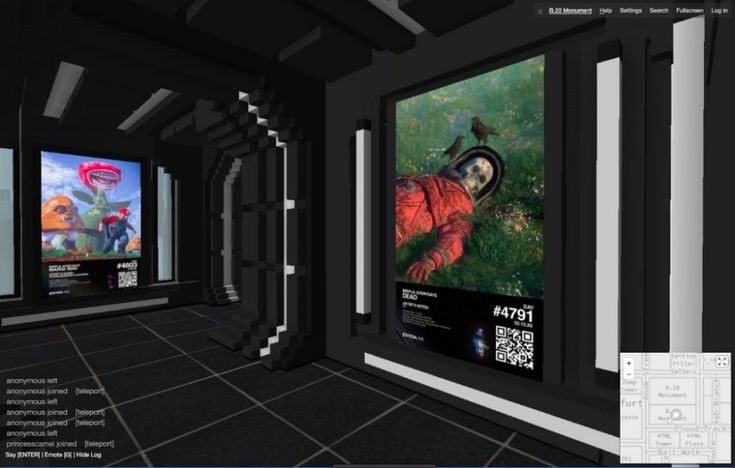
Screenshot of the B.20 Museum in CryptoVoxels, April 24, 2021 | Πηγή εικόνας: moma.or
Αυτό που ξεκίνησε ως “κατάσταση εξαίρεσης” στον τομέα της τέχνης και του design, την περίοδο της υγειονομικής κρίσης δημιουργεί και αναπτύσσει μηχανισμούς κανονικότητας και κανονικοποίησης, δίνοντας στο άτομο όλο και περισσότερο εξελιγμένα και προηγμένα εργαλεία δημιουργίας. Οι νέες αυτές μέθοδοι παραγωγής, ωστόσο, λειτουργούν και καταναλώνονται διαδικτυακά, μετουσιώνοντας την υλικότητα σε κάτι το συμπληρωματικό του επαυξημένου (digital), δηλαδή σε κάτι το επιπλέον, που μπορεί να υπάρξει ενδεχομενικά ώστε να εξυπηρετήσει τις ανάγκες και των “παραδοσιακών” θεσμών (μουσείο, γκαλερί, συλλέκτης, fair κα). Για παράδειγμα, η εκτύπωση NFTs ή η μετατροπή 3D επίπλων σε πραγματικά λειτουργικά συλλεκτικά αντικείμενα.
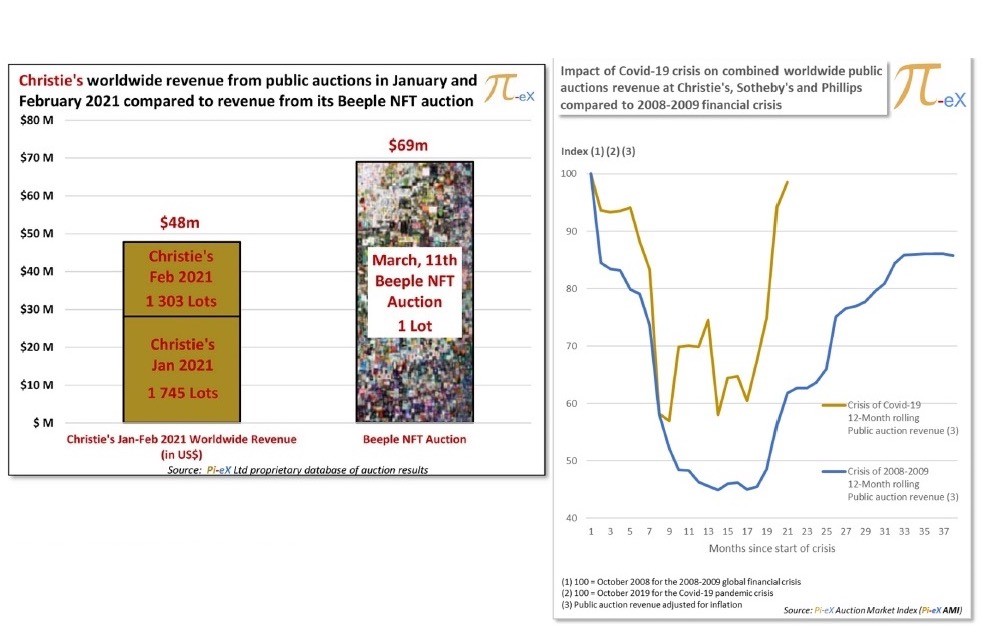
Crisis comparison of impact on public auction revenue (3) at Christie’s, Sotheby’s, and Phillips; 2008–2009 crisis versus COVID-19 crisis—as of end of June 2021.
Comparison between Beeple’s NFT auction (11 March 2021) and Christie’s worldwide monthly results in January and February 2021.
Πηγή διαγραμμάτων: How Has COVID-19 Affected the Public Auction Market? - MDPIhttps://www.mdpi.com › pdf
Μάλιστα, στον τομέα του design βλέπουμε τη ραγδαία δημιουργία προσωπικοτήτων, που εδραιώνονται μέσα από ψηφιακές πλατφόρμες όπως το instagram. Συγκεκριμένα, το τόσο εύκολο άνοιγμα στην παγκόσμια αγορά και η τόσο άμεση επικοινωνία μεταξύ κατασκευαστών, σχεδιαστών, συλλεκτών και θεσμικών φορέων, κάνουν την αλληλεπίδραση να μοιάζει μαζική και συνεχώς αυξανόμενη, ενώ παράλληλα ρίχνουν το κόστος παραγωγής αυξάνοντας παραγωγικά την κοστολόγηση του τελικού προϊόντος. Τα αντικείμενα των σχεδιαστών αυτών πωλούνται σε online δημοπρασίες σε πρωτάκουστες τιμές, ενώ οι ίδιοι ταυτόχρονα διατηρούν τα δικαιώματα στις μεταπωλήσεις των έργων/αντικειμένων τους.
Είναι ενδιαφέρον το πώς η επικοινωνία και κατ’ επέκταση η υποδοχή και αποδοχή (ή και απόρριψη) παίρνουν αριθμητική μορφή αρχικά μέσω των likes και στη συνέχεια μέσω της τιμής ενός αντικειμένου που εκτίθεται ψηφιακά, και πώς η πρόσληψη του αντικειμένου επαναφέρει τον όρο αισθητικά ωραίο στο μεταμοντέρνο κατά τα άλλα λεξιλόγιό μας. Η απόλαυση, ενημέρωση, απόκτηση-συσσώρευση και επικοινωνία της μονάδας, του ατόμου που συνδέεται δηλαδή με άλλους χρήστες, δημιουργεί όλο και περισσότερο την ανάγκη διακόσμησης και τακτοποίησης του ψηφιακού χώρου. Δημιουργούνται έτσι υπέρ-ταυτότητες σε έναν πραγματικά καινούριο, ατελείωτο, δημόσιο χώρο, αυτόν του δικτύου. Επίσης, προκύπτουν νέες απαιτήσεις ως προς τους δημιουργούς, απευθείας από το κοινό τους, ενώ τέλος δημιουργούνται οι ιδανικές συνθήκες ώστε ο κάθε δημιουργός να παράγει μόνος του, αποκομμένος από την κλασική κοινωνική συνθήκη, ανεξάρτητος οικονομικά και ανεξάρτητος από τους “παραδοσιακούς” θεσμούς και τους ιδιαίτερους κανόνες που τους χαρακτηρίζουν.
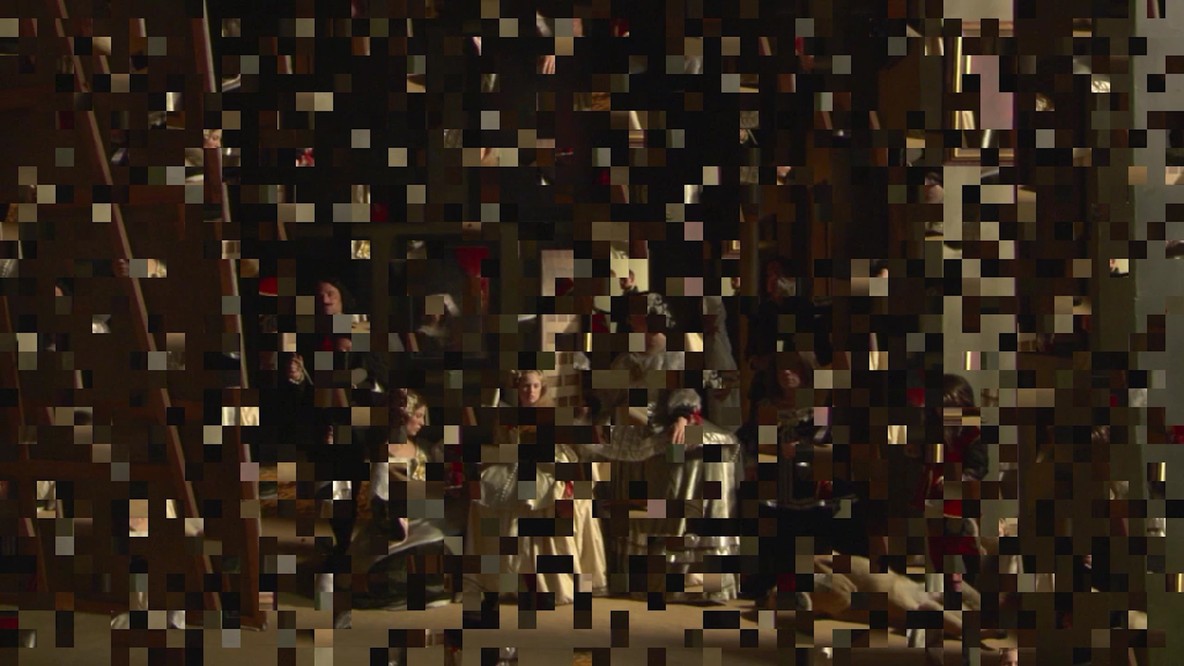
Eve Sussman. 89 Seconds Atomized. 2018. 2,304 NFTs
Φυσικά, η ψηφιακή πραγματοποίηση αντικειμένων προσφέρει ευκολία στον σχεδιασμό, ο οποίος δεν εμπεριέχει τον παράγοντα της υλικής φθοράς αλλά ούτε εκείνον της έρευνας οικολογικού υλικού και της σωστής επεξεργασίας του. Παράλληλα, με την απομάκρυνση από τον φυσικό χώρο, το άτομο “ανεξαρτητοποιείται” από τη φύση και όσα εκείνη σημαίνει, κάνοντας το επιχείρημα περί προστασίας του πλανήτη και πάλι κάτι το θεωρητικό και συχνά θεματολογικό.

“That’s why NFTs are so great because there is a possibility to make colorful ideas with any material without thinking about the manufacturing process” says Temigue – ©Romulo Temigue | Πηγή εικόνας: designwanted.com
Ενδιαφέρον είναι επίσης το πώς επαναπροσδιορίζεται ο όρος αυθεντικό και μοναδικό σε σχέση με τα έργα αυτά, καθώς επίσης και το πώς αυτά προωθούνται μέσα από τον αλγόριθμο της κάθε πλατφόρμας βάσει της ανάγκης του καταναλωτή, όπως ακριβώς τα υπόλοιπα προϊόντα και οι πληροφορίες πάσης φύσεως. Αποδέκτης είναι λοιπόν αυτός που ενδιαφέρεται, το άτομο που επιδιώκει να έρθει σε επαφή με το design ή την τέχνη, αποκλείοντας τη βιωματική εμπλοκή με αμύητο κοινό που δεν είναι “ενημερωμένο”.
Αυτός ο ψηφιακός μετασχηματισμός στον χώρο των κατασκευαστικών και πολιτιστικών βιομηχανιών δημιουργεί το εξής παράδοξο, το οποίο και αναλύθηκε: Αν και η εξατομικευμένη δημιουργία/κατασκευή και προώθηση αποτελούν χαρακτηριστικά μιας εκδημοκράτισης της παραγωγής και απομάκρυνσης από τους θεσμούς και την εκμετάλλευση που αυτοί επιχειρούν, παρατηρείται ταυτόχρονα μια αύξηση της ατομικότητας, πλήρως αποκομμένης από το κοινωνικό σύνολο και τον δημόσιο διάλογο, η οποία μάλιστα δρα και καταναλώνεται σε κόλπους που, αν και είναι περισσότερο ανεκτικοί και ανοιχτοί, παραμένουν το ίδιο εσωστρεφείς, αποφεύγοντας μάλιστα και αποκλείοντας τους κινδύνους που θα επέφερε η επαφή με την κοινωνία στο σύνολό της. Δημιουργούνται λοιπόν και πάλι δυο ταχύτητες που διαχωρίζουν το κοινό και απομονώνουν περαιτέρω τον δημιουργό, ο οποίος παράγει και καταναλώνεται ως υπερ-μονάδα στα πλαίσια μιας νέας ιδιωτικότητας, που παραπέμπει περισσότερο στην καθιερωμένη ρομαντική καταθλιπτική εκδοχή καλλιτέχνη του 19ου αιώνα, παρά σε δυναμικές ριζοσπαστικές φωνές του 21ου, που στοχεύουν στην επίλυση των κοινωνικών, οικονομικών και περιβαλλοντικών προβλημάτων που θεωρητικά εντοπίζουν και γνωστοποιούν μέσω της δουλειάς τους.
Πρόκειται, θα λέγαμε, για μια λογική εξέλιξη της απομόνωσης που βιώνουμε τα τελευταία χρόνια, και είναι ενδιαφέρον πως η τέχνη και το design έχουν βρει τρόπους να επεξεργάζονται τα ζητήματα αυτά (της απομόνωσης, της ψυχικής υγείας, της οικολογίας και της σεξουαλικότητας) θεωρητικά και δημιουργικά και να δημιουργούν συνθήκες βιοπορισμού μέσα από αυτό. Είναι ωστόσο μια κεφαλαιοποίηση στον ψηφιακό χώρο, που, συχνά υπερπληροφορεί χωρίς να επηρεάζει πράγματι ή να “λειτουργεί” κοινωνικά, ενώ παράλληλα απομονώνει περαιτέρω τα άτομα, με τον αλγόριθμο να κάνει τη δουλειά τού διαιτητή (ή ακόμα και μοναδικού χειριστή).
ΠΗΓΕΣ:
https://www.shengwenlo.com/extendable-ears
https://www.the-future-of-commerce.com/2019/01/09/what-is-hyper-individualization/
https://www.artnews.com/art-news/market/online-art-collecting-coronavirus-pandemic-1234573318/
How Has COVID-19 Affected the Public Auction Market? - MDPIhttps://www.mdpi.com › pdf





